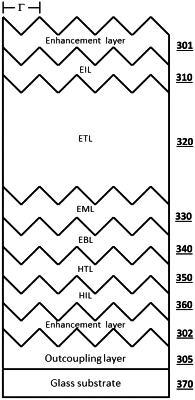| CPC H10K 50/85 (2023.02) [G02B 5/008 (2013.01); H10K 2102/351 (2023.02)] | 20 Claims |

|
1. An organic emissive device comprising:
a substrate;
a corrugated outcoupling layer disposed over the substrate;
a first electrode disposed over the corrugated outcoupling layer;
an emissive stack disposed over the first electrode and comprising an organic emissive material configured to emit light having a peak wavelength λ;
a second electrode disposed over the emissive stack; and
at least one additional layer selected from a group consisting of:
an underlayer disposed below the first enhancement layer, the underlayer having a thickness not more than 4 nλ, wherein n is a refractive index of the underlayer; and
an overlayer disposed over the first enhancement layer, the overlayer having a thickness not more than 4 mλ, wherein m is a refractive index of the overlayer;
wherein at least one layer in the organic emissive device functions as a first enhancement layer in the device and comprises a plasmonic material exhibiting surface plasmon resonance that non-radiatively couples to the organic emissive material and transfers excited state energy from the organic emissive material to a non-radiative mode of surface plasmon polaritons of the enhancement layer.
|